
Impressionism was a 19th-century art movement characterized by relatively small, thin, yet visible brush strokes, open composition, emphasis on accurate depiction of light in its changing qualities, ordinary subject matter, unusual visual angles, and inclusion of movement as a crucial element of human perception and experience. Impressionism originated with a group of Paris-based artists whose independent exhibitions brought them to prominence during the 1870s and 1880s.
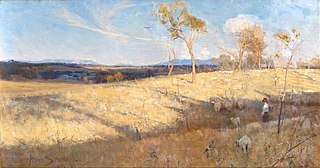
The Heidelberg School was an Australian art movement of the late 19th century. It has been described as Australian impressionism.
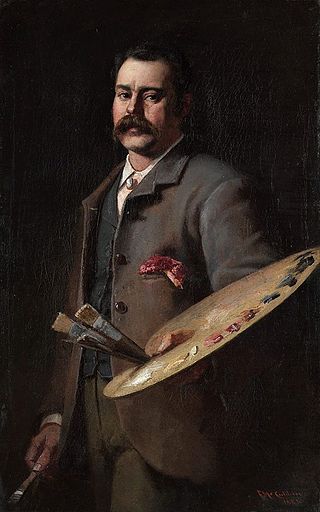
Frederick McCubbin was an Australian artist, art teacher and prominent member of the Heidelberg School art movement, also known as Australian impressionism.
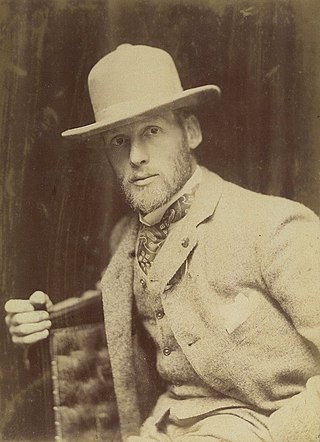
Thomas William Roberts was an English-born Australian artist and a key member of the Heidelberg School art movement, also known as Australian impressionism.

Zhang Xiaogang is a contemporary Chinese symbolist and surrealist painter. Paintings in his Bloodline series are predominantly monochromatic, stylized portraits of Chinese people, usually with large, dark-pupiled eyes, posed in a stiff manner deliberately reminiscent of family portraits from the 1950s and 1960s. Recently, he also created sculptures, translating for the first time into three dimensions many characters of the sort seen in his "Bloodlines—Big Family" portrait series. These sculptures have featured in many exhibits and continue his work as one of China's leading, and most highly sought-after, contemporary artists.

Joan Mitchell was an American artist who worked primarily in painting and printmaking, and also used pastel and made other works on paper. She was an active participant in the New York School of artists in the 1950s. A native of Chicago, she is associated with the American abstract expressionist movement, even though she lived in France for much of her career.
Ma Kelu is a Chinese painter. He first rose to prominence in the late 1970s and early 1980s as a member of a circle of largely self-taught, underground artists based in Beijing, who worked in direct contravention of the Chinese government's official sponsorship of Socialist Realism. After the crackdown against Avant-garde artists during the Anti-Spiritual Pollution Campaign in 1986, he began to show his paintings in the galleries of Berlin, New York, Boston, London, and Vancouver. In 2006, Kelu's work was featured in Beijing, curated by internationally renowned Chinese art historian and critic, Gao Minglu.

David Davies was an Australian artist who was associated with the Heidelberg School, the first significant Western art movement in Australia.
Peter Seitz Adams is an American artist. His body of work focuses on landscapes and seascapes created en plein air in oil or pastel as well as enigmatic figure and still-life paintings. He is noted for his colorful, high-key palette and broad brushwork. Adams has held numerous solo and group exhibitions in galleries and museums, including throughout California, the Western United States, and on the East Coast in Philadelphia, Vermont, and New York. Adams is the longest serving President of the California Art Club and has served on its board of directors in Pasadena, California from 1993 to 2018. He is also a writer on subjects relating to historic artists for the California Art Club Newsletter, as well as for a number of the organization's exhibition catalogs.
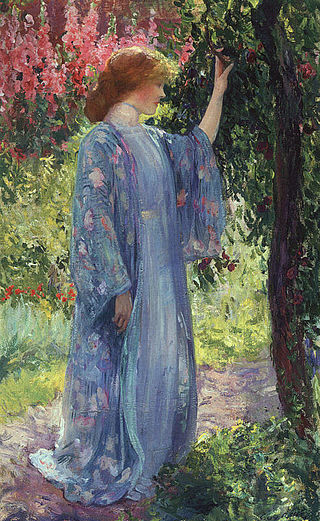
Decorative Impressionism is an art historical term that is credited to the art writer Christian Brinton, who first used it in 1911. Brinton titled an article on the American expatriate painter Frederick Carl Frieseke, one of the members of the famous Giverny Colony of American Impressionists, "The Decorative Impressionist."

Jesse Edwards is an American artist. Known primarily for his figurative and still life oil paintings, using techniques from the European Old Masters, that often provide satirical cultural commentary. His practice also includes painted ceramic sculptures. Edwards studied oil painting at the Gage Academy of Art (2002), and has been exhibiting publicly since. He has been into graffiti twice as long as oil painting or ceramics. After moving from Seattle to New York Edwards acquired representation by Vito Schnabel Edwards work was later chosen by the curators Theo Niarchos and David Rimanelli to be included in group exhibitions alongside works by Harmony Korine, Jean-Michel Basquiat, Andy Warhol, Julian Schnabel, Dan Colen, Dash Snow, and Pablo Picasso.

The Bellagio Gallery of Fine Art is an art gallery in the Bellagio resort, located on the Las Vegas Strip in Paradise, Nevada. It opened along with the rest of the property on October 15, 1998. Like the resort, the gallery was owned by Mirage Resorts, overseen by Steve Wynn. The gallery's collection initially consisted of artwork owned by the company, as well as personal art pieces leased from Wynn.

Post-Internet is a 21st-century art movement involving works that are derived from the Internet or its effects on aesthetics, culture and society.
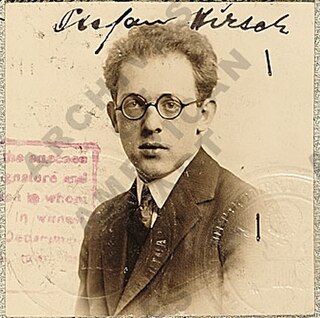
Stefan Hirsch was an American artist. Many of his paintings have the hard edges, smooth surfaces, and simplified forms of the precisionists and their typical subjects—cityscapes and industrial scenes—are sometimes also his, but in general his works have an emotional element and, as one critic as said, "take on an otherworldly tone" that sets them apart. In addition to work showing a personal version of precisionism, he produced paintings, drawings, and prints in the social realist, Mexican muralist, and surrealist styles as well as still lifes, portraits, and landscapes that defy easy classification. His work achieved critical recognition from 1919 onward, has been widely collected, and is today found in many American museums including the Phillips Collection, the Whitney Museum of American Art, the Metropolitan Museum of Art, and the Corcoran Gallery.

Stefan Simchowitz is a Los Angeles based politician, art collector, art curator, and art advisor. He is a vocal proponent of social media as a legitimate way of discovering, distributing, and popularizing the fine arts, primarily using Facebook and Instagram as platforms for self-promotion, discovering new artists, and endorsing those he already manages.
Emily Parker Groom (1876–1975) was an American artist born in Wayland, Massachusetts. She remained an active painter until the age of 97, spending nearly her entire career in Wisconsin, and died in Milwaukee, Wisconsin.
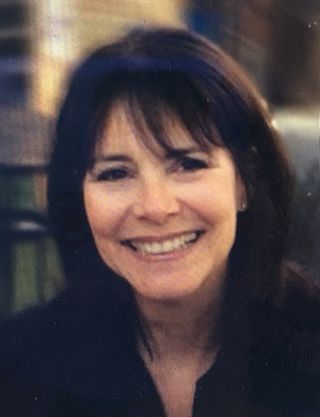
Susan Cox is an American painter. She is completed work in oil, acrylic, and watercolor mediums. Her work focuses on City Scenes and life and Landscapes en plein air. Her work has been showcased across Europe and the United States.
Hannah Black is a British visual artist, critic, and writer. Her work spans video, text and performance. She is best known for her open letter written with Ciarán Finlayson and Tobi Haslett, The Tear Gas Biennial, criticizing co-chair of the board of the Whitney Museum, Warren Kanders, and his philanthropic endeavors. These are allegedly made possible through the sale of tear gas and other weapons via Safariland. The letter prompted artists to withdraw works from the 2019 Whitney Biennial.
Ibrahim Mahama is a Ghanaian author and an artist of monumental installations. He lives and works in Accra, Kumasi and Tamale, Ghana. He is the founder of Red Clay Studio, Savannah Centre for Contemporary Arts and Nkrumah Volini.
Château Shatto is a contemporary art gallery in downtown Los Angeles, California directed by co-founder Olivia Barrett.














